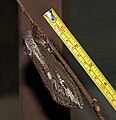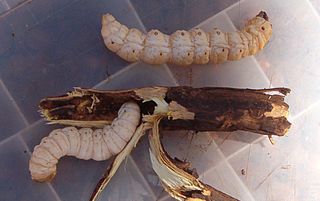
The witchetty grub is a term used in Australia for the large, white, wood-eating larvae of several moths. In particular, it applies to the larvae of the cossid moth Endoxyla leucomochla, which feeds on the roots of the witchetty bush that is widespread throughout the Northern Territory and also typically found in parts of Western Australia and South Australia, although it is also found elsewhere throughout Australia.

Acacia kempeana, commonly known as wanderrie wattle, witchetty bush or granite wattle, is a shrub in subfamily Mimosoideae of family Fabaceae that is endemic to arid parts of central and western Australia.
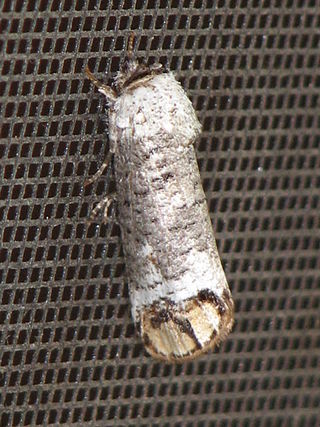
The Cossidae, the cossid millers or carpenter millers, make up a family of mostly large miller moths. This family contains over 110 genera with almost 700 known species, and many more species await description. Carpenter millers are nocturnal Lepidoptera found worldwide, except the Southeast Asian subfamily Ratardinae, which is mostly active during the day.

The crested bellbird is a medium-sized passerine bird in the family Oreoicidae. It is native to drier parts of Australia where its typical habitats are acacia scrublands, eucalypt woodlands, spinifex and saltbush plains, and dunes. The male is about 20 cm (8 in) long and has a grey head, a black crest and breast, and a grey or olive brown body. The female and juvenile are similar but the colours are more muted and the black breast is lacking. The distinctive call is a high pitched bell-like sound, audible at some distance. Sometimes a pair of birds duet.

Glochidion ferdinandi, with common names that include cheese tree, is a species of small to medium–sized trees, constituting part of the plant family Phyllanthaceae. They grow naturally across eastern Australia, from south–eastern New South Wales northwards to northern and inland Queensland, in rainforests and humid eucalypt forests. Frugivorous birds such as pigeons, figbirds and parrots consume its fruit.
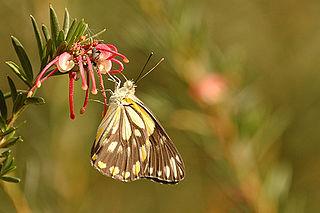
Belenois java, the caper white or common white, is a small butterfly of the family Pieridae found in Australia, Indonesia, and Melanesia. It is highly migratory and is often confused with the cabbage white.

Thalaina clara, or Clara's satin moth, is a moth of the family Geometridae. The species was first described by Francis Walker in 1855. It is endemic to south-eastern Australia.

Chenuala is a monotypic moth genus in the family Anthelidae described by Charles Swinhoe in 1892. Its only species, Chenuala heliaspis, the rose anthelid, was described by Edward Meyrick in 1891. It is endemic to Australia.

Anthela nicothoe, the urticating anthelid, is a moth of the family Anthelidae.

Abantiades latipennis, known as the Pindi moth, is a species of moth in the family Hepialidae. It may also be referred to as a swift moth or a ghost moth, as this is a common name associated with Hepialidae. Endemic to Australia and identified in 1932, it is most populous in temperate rainforest where eucalypti are prevalent, as the larvae feed primarily on the roots of these trees. Females lay eggs during flight in a scattering fashion. The larvae live for over eighteen months underground, while adult moths survive for approximately one week, as they have no mouthparts with which to feed. The moths are preyed upon by a number of predators, including bats and owls. Brown in colour overall, males are paler and the identifying silver bars of the male's wings are more prominent than those of the female's, with dark margins. Male adults are generally smaller.
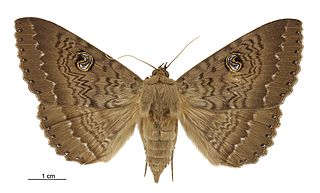
Dasypodia cymatodes, the northern old lady moth or northern wattle moth, is a moth of the family Noctuidae. The species was first described by Achille Guenée in 1852. It is found in Australia, and is self introduced in New Zealand.

Ochrogaster lunifer, the bag-shelter moth or processionary caterpillar, is a member of the family Notodontidae. The species was first described by Gottlieb August Wilhelm Herrich-Schäffer in 1855. Both the larval and adult forms have hairs that cause irritation of the skin (urticaria). The adult moth has a woolly appearance and its wings can grow to be about 5.5 cm across. The larvae feed on Grevillea striata at night and reside in brown silken bag nest during the day.
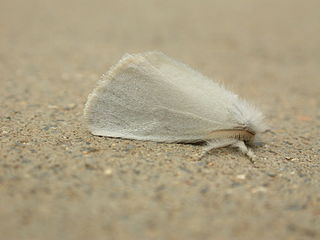
Acyphas semiochrea, the omnivorous tussock moth, is a moth of the subfamily Lymantriinae first described by Gottlieb August Wilhelm Herrich-Schäffer in 1855. It is found along most of the coast of Australia, including: New South Wales, Queensland, South Australia, Tasmania, Victoria and Western Australia.
Houdinia is a monotypic genus of moths in the family Batrachedridae. Its sole species, Houdinia flexilissima, is endemic to raised bogs in northern New Zealand. It is classified as "At Risk, Relict" by the Department of Conservation. The caterpillars are sometimes referred to as Fred the thread.

Endoxyla lituratus is a moth of the family Cossidae. It is found throughout Australia.

Xyloryctidae is a family of moths contained within the superfamily Gelechioidea described by Edward Meyrick in 1890. Most genera are found in the Indo-Australian region. While many of these moths are tiny, some members of the family grow to a wingspan of up to 66 mm, making them giants among the micromoths.
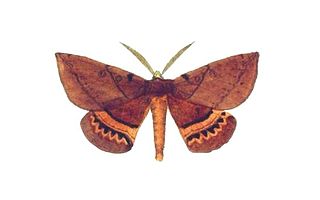
Chelepteryx chalepteryx, the white stemmed wattle moth or white-stemmed acacia moth, is a moth of the family Anthelidae. The species was first described by Rudolf Felder in 1874. It is found in Australia.
Hypodoxa bryophylla, the green looper moth, is a moth of the family Geometridae. The species was first described by Gilbert M. Goldfinch in 1929. It is found in the Australian states of Victoria, New South Wales and Queensland.

Endoxyla cinereus, the giant wood moth, is a moth in the family Cossidae. It is found in Australia and New Zealand. The species was first described in 1890. A rare contemporary sighting of the moth at a school in Australia garnered notice as an editor's pick among the daily headlines of the New York Times on May 8, 2021.


